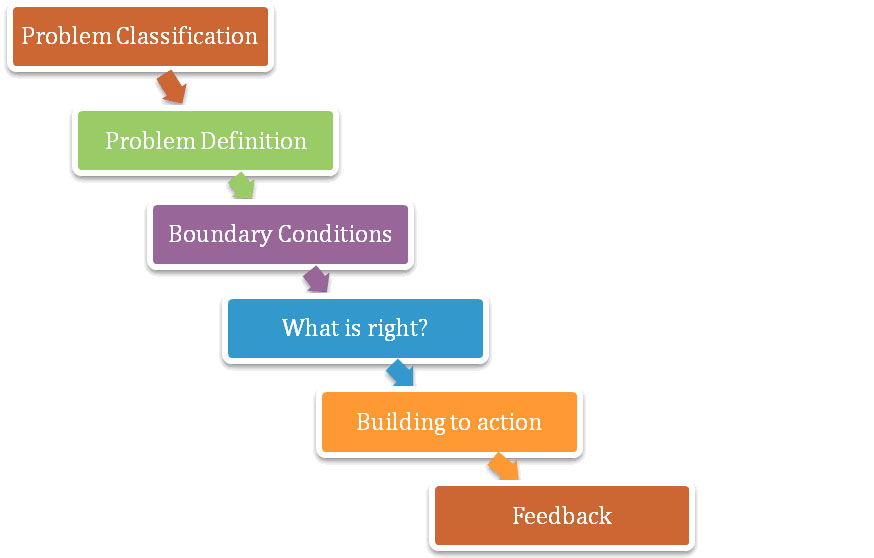Part 3.

Inexorably linked. Put simply, the outcome of a leader’s choices and decisions can, and usually will, make or break them. The fact of the matter is that senior executives who rise to the C-suite do so largely based upon their ability to consistently make sound decisions. What most fail to realize is while it may take years of solid decision making to reach the boardroom, it often times only takes one bad decision to fall from the ivory tower. As much as you may wish it wasn’t so, when it comes to being a leader you’re really only as good as your last decision.
Here’s the thing – even leaders who don’t fail make bad decisions from time-to-time. When I reflect back upon the poor decisions I’ve made, it’s not that I wasn’t capable of making the correct decision, but for whatever reason I failed to use sound decisioning methodology. Gut instincts can only take you so far in life, and anyone who operates outside of a sound decisioning framework will eventually fall prey to an act of oversight, misinformation, misunderstanding, manipulation, impulsivity or some other negative influencing factor.
5. UNDERSTANDING GOOD DECISION-MAKING PROCESS
Peter F. Drucker, wrote an article on decision-making in 1967 that still stands the test of time.
Drucker commences by stating that an effective decision making process must go through some basic steps. These steps will not “make†the decision – it will always be a judgement call – but if the steps are ignored, the decision is not likely to be either effective or right. The 6 steps he recommends are:

Step 1: Problem classification
Drucker postulates that a decision falls into 2 broad categories: generic (where the situation has happened before and a set of rules or principals may be applied) or unique (must be treated individually and pragmatically).
Why is this important? When you see that a problem is generic then you are able to search for patterns, previous patterns and resources you used.
Step 2: Problem definition.
Here the decision maker must work out what the situation is all about and what are the key issues. The danger, he claims, is that of an incomplete definition but one that is plausible. The only safeguard being to check the definition again and again against all the observable facts and throw out the definition the moment it fails to encompass them.
Step 3: The specifications (“boundary conditionsâ€)
It must be clearly defined what the decision must accomplish, that is what are the minimum goals it has to attain. In science, these are known as boundary conditions. Drucker says that a common problem in decision making is not necessarily the wrong decision, but a circumstance when the boundary conditions change while the decision is being implemented – such as may have happened to organisations who started a decision process pre-recession and are now trying to implement it in the midst of the economic crisis.
He also states that another reason to have boundary conditions clearly defined is in when one is making the most dangerous of all decisions – which is when the conditions are essentially incompatible. That is when the decision might, if nothing goes wrong, work. This is what he calls little more than “gamblingâ€.
Step 4: The decision: what is right
It is critical to decide what is right. That is not to say that a compromise may not eventually have to be made when implementing (inevitably it will), but rather start with the best decision that meets all the boundary conditions and  then, if necessary, compromise from that position. Drucker brilliantly demonstrates this by explaining there are two types of compromise. One is expressed in the proverb: “Half a loaf is better than no breadâ€. The other in the story of the Judgement of Solomon where it is realised that “half a baby is worse than no baby at allâ€! In a nutshell, he is saying that we should not be thinking about “what will be acceptable†to others (at least initially), rather “what is the right answer?â€.
Step 5: Converting the decision into action.
Drucker says that a decision is not a decision until it has been acted upon. He goes further to state that the action should be built into the decision from the outset. He suggests 4 distinct questions:
- Who has to know of the decision?
- What action has to be taken?
- Who is to take it?
- What has to be done so that these people can take the action?
He notes that the first and last questions are most frequently overlooked and then reminds the reader that the action must be appropriate to the capacities of the people who have to carry it out.
Step 6: Feedback
Drucker reinforces that men are fallible and decisions can go wrong and may not achieve their desired results. Therefore a feedback mechanism must be put in place to monitor and report back on the success or otherwise of the outcome. He says that effective decision makers realise that often they should not rely on reports but, like military commanders, must go into the field themselves to see how the decision is being carried out. Peter Drucker, with accurate foresight (remember this was written in 1967) warns that with the advent of computers this is even more important as computer-generated reports only can report back on abstractions. A final comment in this section is “Failure to go out and look is the typical reason for persisting in a course of action long after it has ceased to be appropriate or even rational.â€
6. SEEK ADVICE FROM TRUSTED ADVISORS
Only secure, humble people realise that they may be seeing a decision anaemically and that they need help to fill out the options, or have the courage to do what they believe is the right decision.
For all the important decisions I have ever taken I have sought out wise men and women to help me think through and weigh up the decisions before me. One of the reasons for this is because I know that I have limiting beliefs about what I can and can’t do. When I was recently talking with my mentor about a decision it became clear that I had a certain unhelpful pattern. I would never have seen or admitted to it by myself.
Other times mentors and advisors have given me their counsel from years of experience that I don’t have.
There is a time to move beyond just trusted advisors. There are no private decisions. Sooner or later the details surrounding any decision will likely come out. If your decision were printed on the front page of the newspaper how would you feel? What would your family think of your decision? How would your shareholders and employees feel about your decision? Have you sought counsel and/or feedback before making your decision?
However, making decisions by committee is difficult. Everyone has their own views, and their own values. And while it’s important to know what these views are, and why and how they are important, it may be essential for one person to take responsibility for making a decision. Sometimes, any decision is better than none.
It is important to balance these two forces by seeking out wise, trusted people to help you with a decision. It is important that you set the ground rules for the discussion. For instance, if you know they have a certain bias, let them know that you are aware of it. If you are seeking them to help you by asking questions only, tell them this. If you are wanting their opinion, makes sure you let them know that you will not hold them responsible if the decision turns out not to be wise.
EXERCISE:
As an exercise take 10 minutes to answer these questions:
- How skilful are you in making decisions?
- What type of decision do you find most difficult?
- What type of style is your default style?
- What process do you follow when making a decision?
I’d love to hear your feedback. Email me at Craig@transformleader.com.au or put a comment in the comments section.
